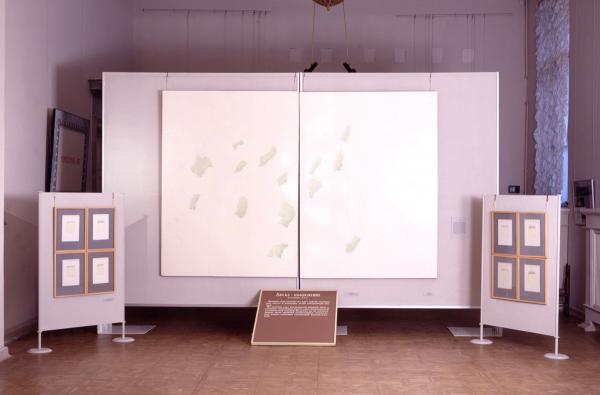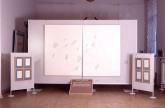The Garden
Installation. 1978, 1979
- enamel on hardboard. Diptych: 260 x 290 each. Explanatory text: 117 x 105. 24 framed texts: C. 51 x 34,9 each
- НТ-272/1-2, а; 272/6
- Period Late 20th century – 21st century
- CategoryAbstraction
- Share
Ilya Kabakov is the founding father and leading representative of Moscow Conceptualism, the leading movement in unofficial Soviet art. The artist mostly closely associated with modern Russian art in the West, the central subject of his oeuvre was the life of the Soviet communal flat and its effects on the national mentality. Garden is an example of a composition in which the main subject of Russian Conceptual art — the correlations of the representation and the text, the visual image and the commentary — are reflected. The priority of the textual reality is confirmed in no uncertain terms. The representation cannot live or be seen without the verbal explanation. Russian Museum: From Icons to the Modern Times. Palace Editions, St Petersburg, 2015. P. 366.
The only painterly element in this multipartite installation is the diptych. A further panel contains an explanatory text that describes the painting in detail. The painting is flanked by framed pictures, which themselves are texts, imaginary viewers' commentaries on The Garden invented by Kabakov. These statements range from brief descriptions, banal or intelligent interpretations, all the way to fragments of overheard conversation that appear to have no connection with the painting at all.
In many of his works Kabakov explores the relationship of language to writing and visual imagery. Both in the classical modern tradition and in that of Socialist Realism — if under a different sign — commentary inherent in the image plays an important role. Il'ja Kabakov mistrusts texts profoundly.
The Garden graphically illustrates the dubious nature of commentary and interpretation by quoting texts whose absurdity demonstrates the impossibility of making a clear, let alone an ideologically colored, statement about a work of art. In addition, the texts presented by the artist as little paintings, whose context in the overall installation prompts us to read them as paintings rather than texts, blurring the distinction between the linguistic and the visual level.
The only painterly element in this multipartite installation is the diptych. A further panel contains an explanatory text that describes the painting in detail. The painting is flanked by framed pictures, which themselves are texts, imaginary viewers' commentaries on The Garden invented by Kabakov. These statements range from brief descriptions, banal or intelligent interpretations, all the way to fragments of overheard conversation that appear to have no connection with the painting at all.

